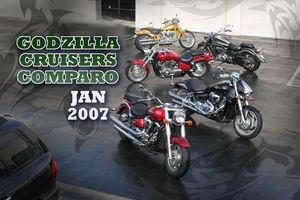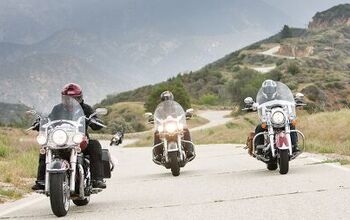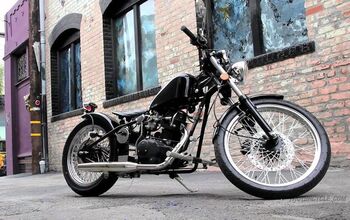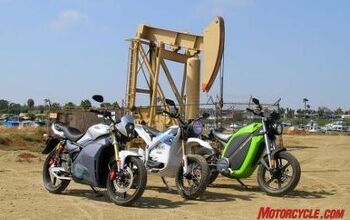Godzilla Cruisers Shootout - Motorcycle.com
Godzilla name is the property of Toho Films, Ltd.
Is bigger better?
Since we're all Americans here, we don't even have to ask that question. Of course it is.
And nowhere is that more true than in the land of the cruiser motorcycle.Just 10 years ago, Motorcycle.com posted its first heavyweight cruiser comparison test. Back then, "big" was 1,100cc, and "huge" was 1,500. Things have changed. Cruisers are bigger, with better
We do. In fact, we need five of them, just because we can. We dialed up our favorite OEMs and had them send over the biggest, baddest, nastiest, most-expensive mutant reptilian jumbo-cruisers they had. From Harley-Davidson came their outrageous CVO Springer, Honda sent a VTX1800C, Kawasaki rented a flatbed to bring us a colossal Vulcan 2000, Yamaha shipped in a Star Roadliner, and to satisfy all of you who whined about its absence from our Power Cruiser comparison last year, Suzuki ponied up the pony-packing Boulevard M109R. They are all big, comfortable, cushy weapons of mass destruction that are fun to ride but maybe not so fun to pay for. Which bike would we buy if we had to buy one of these? We decided to take them out on the road to find out.
After getting on the bat-phone to round up our usual crew of LA-area guest testers, we hit some canyons, freeways and city streets for some serious mileage before strapping these beasts to our much-abused Dynojet Dynomometer to find out how much torque it takes to warp a 1,000-pound steel drum. After that we tallied up our notes and votes to see what was beneath all that chrome, plastic, enamel, steel and hype to see what bike was the one we'd probably recommend to a friend, or buy ourselves if one of us magically happened to be sufficiently solvent to actually buy something like this. Big guys like to get straight to the point -- heck, Godzilla himself used to dry-swallow a few cargo ships before breakfast -- so let's cut the crap and get right to it.
The Contenders
Ebira, Horror Of the Deep: Honda VTX 1800C $12,899
Honda's engineers wanted a bike that had a thumpy, powerful feel, yet was still smooth, refined and easy to ride. Starting at the bottom, they made a 41-pound twin-pin crankshaft with dual balance weights and bolted that to the biggest pistons and rods Honda ever made. It uses a 101mm bore and 112mm stroke to make 1,795cc of liquid-cooled and liquid-smooth power, delivering 89.1hp and 102.25 foot-pounds of torque to the much-abused (but still faithfully accurate) MO Dynojet Dynamometer. Dual throttle bodies feed the three-valve cylinder head, and a five-speed gearbox and driveshaft gets power to the back wheel.
The chassis is big and heavy, but still features Honda refinements and features. The tube-steel frame sets the front 130/70-18 radial tire 67.5 inches from the rear 180/70-16. Suspension duties are handled by a grande 45mm inverted fork in front, with dual shocks adjustable for preload in back offering 3.9 inches of travel. Brakes are dual three-piston calipers in front with 296mm discs, while the back gets a single 316mm disc and two-piston caliper. Front and back brakes are linked with Honda's LBS system, which activates all three calipers when a rider applies the rear brake. The big red enchilada weighs in at 734 pounds (claimed dry weight).
The first impression the bike makes is a smooth, slick tidiness. Honda gets a lot of flack for making solid, good-performing machines that come off as being too refined -- bland, even. Our testers used terms like "middle of the road", "subtle", "utilitarian" and of course, "bland" to describe the styling, although Pete liked the "tough-looking" billet wheels, inverted fork and clear turn-signal lenses. The Honda has convincing looks, but it definitely doesn't stand out in this company.
On board, that utility serves the rider well, with nicely finished, solid-feeling (if a little dated looking) controls and good ergonomics. The reach to the drag bars is nice, and the seat is "the best balance between firm and soft", according to Pete. The pegs aren't too far out front, but there's still plenty of room for the tall among us. It's the "most efficient" riding position of all these bikes in Pete's opinion, and that's a good thing on any motorcycle.
Around town, the bike's heft melts away above a walking pace and the linked brakes are seamlessly useable. On the freeway, although windblast is predictably strong over 70 mph, the splendid ergos and comfy seat make it a joy to rack up mileage on. At all speeds the wide bars and solid chassis make the bike maneuverable, even sprightly.
On a twisty road, this bike is second only to the Suzuki. It felt to Pete like it had the best ground clearance (although Petey might have just been in a good mood when he was riding the VTX), and the light feel and seamless motor lets the rider get into a groove and flow with the curves. Those good ergos also let the rider get more aggressive more comfortably. The VTX tackles winding roads with the competence expected of a Honda product, with light-ish steering, well-damped suspension and a stable chassis.
...that utility serves the rider well...At the end of the day, the Honda drips with competence and value, but just isn't the machine we'd take if there were other keys hanging on the wall. As Buzz said, "at first I thought I might vote it number one just because it's similar in performance to all the others and can be had for a fraction of the price of the Star or Harley," but then he realized, like the rest of us did, that this is a cruiser, and a flagship cruiser, at that. These bikes are great because they have an outrageous presence, but the VTX1800C is "like a giant Shadow 750", according to Buzz. It just doesn't arouse any real passion; "middle of the road", according to Jack, and "just another metric cruiser" according to Gabe. Sure, it's competent, great-performing and a sure value, but we're demanding souls here at Motorcycle.com and the VTX just didn't deliver that extra level of special-ness that we need to want to own something.
Gamera: Suzuki Boulevard M109R $12,599, $12,999 Special Edition
Where's the M109R?
This Boulevard is a real monster. We told you about it last year in Ken Glassman's intro report, and we really have been itching to test it since then. Ken raved about the bike's power and handling; how can crossing a GSX-R with a big-bore cruiser be a bad thing?
You can go check that story out for full specs and details, but basically the Suzuki engineers started with a clean sheet of paper. It's a "modern 54-degree, liquid-cooled, DOHC, four-valves-per-cylinder V-twin displacing 109 cubic inches (1,783 cc)", according to Glassman's report, with the biggest pistons of any gasoline-burning motor anywhere. All sorts of high-tech bits keep the motor powerful and as compact as possible, including a two-stage cam drive system, dual sparkplugs, a 32-bit ECU and special piston liners for the forged-aluminum pistons. It all adds up to 106.4hp and 101.3 pound-feet of torque, with a remarkably linear horsepower "curve" that's as close to a 45-degree angle as anything we've see come out of our Dynojet dynamometer.
The bike is finished with plenty of painted plastic covers and faux chrome, as well as some functional bits. The wheels are cast aluminum, with fat 18-inch radial Dunlops; a 130/70R18 front and a biggest-in-the-test 240/40R18 in back. There's also a 5.2-gallon tank and a nice solo seat cover, which comes off with a key so you can replace it with the included passenger seat. Hopefully the passenger isn't a copyright attorney working for Victory; the rounded back end with fat back tire looks a lot like the Victory Hammer.
Suzuki is definitely trying to be original and different, and we all heartily supported the ethos if not the execution. Although the bold, flowing lines "look good from ten paces", according to Gabe, (who also looks good at ten paces) closer inspection reveals "acres of flimsy plastic" according to Buzz, who dubbed the `Zook the "ugly V-Rod", with an "odd convulsion of shapes". The big seam on the bottom of the tank isn't too endearing, either, nor is the big, bulbous thing behind the headlight. It's not Madura-ugly, but it's not winning any beauty contests anytime soon, although Pete appreciated the styling, saying it "epitomizes muscle bike."
Hey, you can't see it while you're riding it (unless you pass some of Buzz's plate-glass windows), and the view from the broad, cushy saddle is much better. The M109R also has a nice reach to the bars, with a markedly compact seating position. Jack thought the footpegs were far forwards, making an "odd" seating position, but Gabe liked the tight cockpit feel and "almost perfect" seat. The controls are decent as well, with a nicely-positioned control panel, but Pete and other testers thought the rear brake was set too close to the footpeg, making it uncomfortable.
On the road, the bike reveals its sporty, nimble nature. It's no surprise Kevin Schwantz was at the press introduction for this bike; it really has a lot of sportbike DNA in there. It turns lightly and quickly, is dead-stable on high-speed sweepers, and in general bests most of these bikes, handling-wise. There's even a reasonable amount of cornering clearance. The only real quibble is the suspension, which we found to be hard; "on anything less than perfect pavement, the ride can be very jarring", said Pete. This seems to be a trend with driveshaft-equipped bikes, yet another reason why belts should be universal on cruisers.
You certainly can't fault its road manners, brakes or motor. The brakes are as good as you'd expect, with more than enough power to overwhelm the front tire, but Pete noted a slightly "wooden" feel to the lever. This is probably because the long wheelbase, rearward weight bias and heavy weight of a cruiser limit the effectiveness and feel of any brakes, regardless of how fancy they are.
Riding back home from a nice two-lane road, the M109R takes good care of its rider. Wind protection is ample, vibration is a soothing thump at freeway speeds in top gear, and the seat coddles you. It's a great way to rack up miles, ready for any kind of road. So why did it finish a close third to the Harley and Kawi? You certainly can't fault its road manners, brakes or motor. You can live with the niggling FI issues, and the price is the lowest here. But the styling and attention to detail are more mid-priced than flagship cruiser, which changes this bike from an object of desire to just another collection of techno-wonders. If you want ultimate power, braking and handling the GSX-R1000 is the way to go, but a cruiser has to look as good as it goes. That's a tall order for something that goes as good as this, but it can be done. Just not this time.
Mothra: Harley-Davidson CVO FXSTSSE Screamin' Eagle Softail Springer $24,995
Harley-Davidson thinks they have the answer with their Custom Vehicle Operations (CVO) division. Since 1999, the CVO people have been satisfying America's need for custom bikes by building factory custom bikes loaded with custom paint and generous helpings of performance and cosmetic upgrades from the H-D accessory catalog. While the bikes are priced substantially higher than the stock models they're based on, the total package is significantly less than it would be if the customer purchased a standard bike and souped it up part by part.
We figured a CVO bike would be Harley's ultimate expression of outrageous, mutant bigness, and the Softail Springer was what they had on hand for us to test. The CVO guys start with the counterbalanced 96 cubic inch (1,584cc) Twin Cam motor, give it a silver powder coat and chrome treatment and punch the bore out to 101.6mm, for a new displacement of 110 cubes (1,800cc). Compression gets a teeny .2 boost for a 9.3:1 ratio, and the electronic sequential-port fuel injection gets a Stage One Screamin' Eagle air cleaner. Aside from the chrome slash-cut mufflers and a hydraulic clutch, the rest of the motor is pretty much standard, with the new six-speed transmission and other improvements that make the new Harley Big Twin lineup so nice to ride. It's good for 81.46hp and 95.58 foot-pounds of torque on the MO Dynojet Dyno.
The rest of the bike gets all kinds of fancy features. There's a leather two-up seat, chrome accessories too numerous to list, a cool mini tachometer mounted on top of the internally-wired chromed drag bars, an even cooler LED fuel gauge set into a chrome panel in the tank, and a flush fuel-filler cap. A keyless security system, which uses a fob to let the bike know when the rider is on the bike, comes standard, along with a special CVO ignition key. The package weighs in at 694 pounds dry (claimed), costs $24,995, and they will make just 2,500 of them, in three different colors.
After climbing onto the leather saddle and grabbing those slick custom billet grips, the bike is easier to haul upwards than most of these big bikes. The saddle isn't too hard, and boasts a seat low enough for Gul Mohammed to ride easily, which -- when combined with the comfortable reach to the drag bars -- puts the rider perfectly in control. Hopefully you have that alarm key fob in your pocket, otherwise the bike will be chirping and shrieking at you until you get off and run away.
The bike starts up easily, and rewards the highly-entertained rider with a very nice sound through those slash-cut shotgun duals that will unfortunately not be loud enough for most of you Harley faithful. The hydraulic clutch engages smoothly, as does the re-worked transmission. The motor is "sweet," according to Buzz; "it rips away from stoplights with easy burnouts", and is plenty powerful, especially given the chassis and brakes, but in this company it's noticeably down on power. Still, it's a great cruiser motor, as well as the most `authentic'.
The big chrome springs up front make squeaky bedspring noises, but the front end works OK if you don't push it too hard. However, where it does have limits is with that single-piston, single-disc brake. "It's OK to be in a hurry, as long as you're not in a hurry to stop" offered Gabe, but the brake system is far from dangerous or inadequate; the rear brake offers plenty of power and feel, and the front gets the job done if you give it enough digits. But still, let Buzz tell you: "it likes to go but doesn't like to stop." You have been warned.
Luckily, motorcycles are about going, and the CVO is reasonably competent going around corners. Ground clearance runs out predictably early, but as long as you don't push it too hard -- or maybe don't push it hard at all -- the bike will go ...this bike is best suited for cruising the strip and looking good... through corners dutifully enough. Pete thought that "despite the 21-inch front wheel, the Springer changes direction quite easily", and the long wheelbase and good Softail frame keep things stable enough. That lowered rear and antiquated front are the price of fashion, though, and overall, to quote Pete, "this bike is best suited for cruising the strip and looking good...extended freeway time or excessive amounts of twisting roads really are outside of the scope of the Springer's design."
Some of us wondered if the CVO wasn't out of place in this company. But Gabe disagrees; "there are plenty of buyers out there who want the biggest, most-expensive bike around, and this is the biggest-displacement motor Harley offers." For those buyers, there is no replacement for displacement, and that big "110" sticker on the air cleaner speaks to the importance of big numbers. It's big, beautiful to look at and is a practical, user-friendly everyday ride, especially if your everyday ride is on smooth, low-speed pavement.
Still, the CVO really isn't that bad to ride and made a pretty impressive showing. Things might have been different for Harley-Davidson if we had tested the VRSCX, but that's no Godzilla-bike. That bike is more like Ultraman.
More by MO Staff









































Comments
Join the conversation